Pawscessories is reader-supported. When you buy via links on our site, we may earn an affiliate commission at no cost to you.
Learn more.
Crate training any dog can be a time-consuming challenge, especially with a dog that has separation anxiety. However, while it may take some time to familiarize your pup, it’s a great way to keep them calm and less worried when you have to leave.
To crate train an older dog with separation anxiety you’ll first need to get them used to being in their crate while you’re around. Once being in their crate is no issue, you’ll want to gradually increase your time away while they’re in the crate.
For an in depth, step-by-step guide on crate training an older dog with separation anxiety, keep reading.
The worst thing you can do is leave your pup feeling this way when you’re not around.
They’re likely barking excessively while you’re gone (and bothering your neighbors), leaving a mess in your home from either destroying things or having accidents, or worst case, harming themselves while having their fit.
Here are some helpful tips on how to crate train an older dog with separation anxiety.
Table of Contents
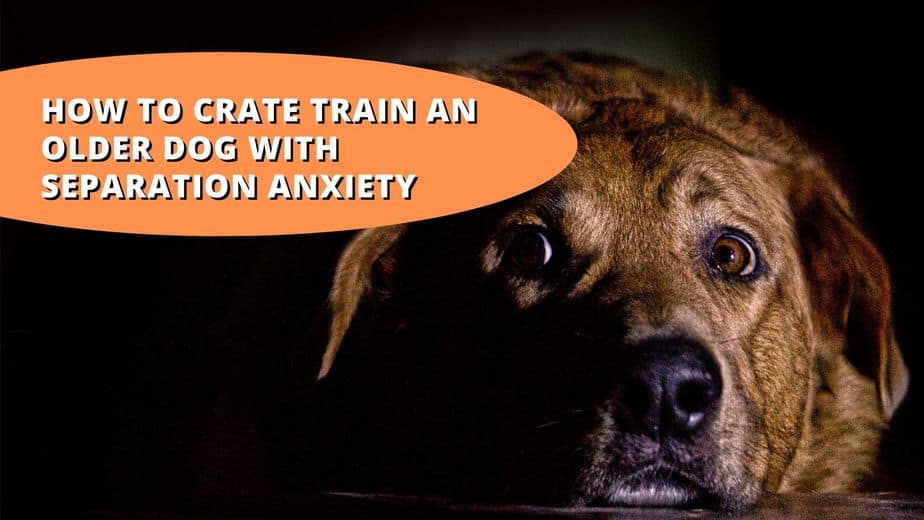
What Is Separation Anxiety In Dogs?
Generally speaking, dogs are devoted to their owner. A dog who suffers from separation anxiety feels nervous and out of sorts when their owner is away or nowhere to be seen or heard.
Some dogs show signs of anxiety at a mere threat of separation. Most dogs prefer their owners to be close by. But, some dogs undergo separation anxiety.
If a dog has separation anxiety, he or she will whine or begin trembling when you are about to leave. The dog may bark or howl very loudly and for long periods of time while you’re absent.
Some might scratch the furniture, walls, doors, or anything nearby. Some may chew everything in sight to bits.
Additionally, dogs with separation anxiety may lose control of their bladders or bowels.
When an older dog has separation anxiety this is especially troubling since they may already have frequent accidents due to their age.
Should Dogs With Separation Anxiety Be Crated?
The simple answer is yes, dogs with separation anxiety should be crated.
Crating an anxious dog may seem cruel, but it’s actually the best way to keep them safe from hurting themselves or destroying your home while you’re away.
When crated, an anxious dog can’t pace back and forth, work themselves into a frenzy, or destroy your things.
A dog crate also provides a feeling of security for an anxious dog. It’s their own little space where they can feel safe and relaxed. So crate training a dog with separation anxiety is a good idea.
How To Crate Training An Older Dog With Separation Anxiety
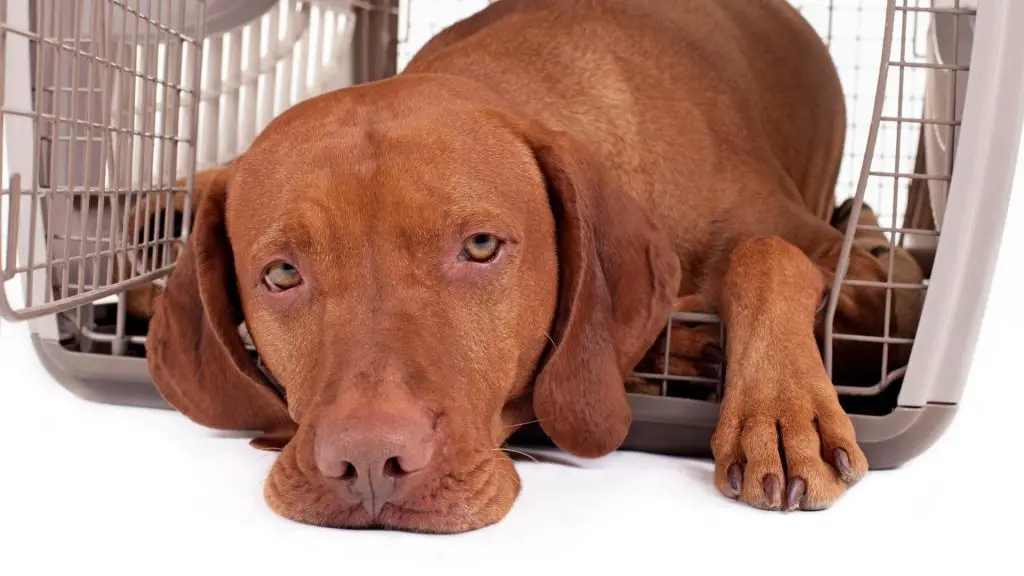
While the process may take some time, don’t give up hope thinking it will never happen. Remember, you are doing this to make sure your pup is safe and secure when you have to be away.
Here are the steps you can take to crate train an older dog with separation anxiety:
- One Size Does Not Fit All
- Make Their Crate Comfortable
- Familiarize Their Crate
- Get Them Comfortable Inside
- Shutting The Door
- Moving Further Away
- Gradually Increase Time Away
- How To Know When To Stop
- Words Of Caution
- Make It Their Home
1. One Size Does Not Fit All
Make sure you get the right-sized crate.
Think Goldilocks and the Three Bears here. Get a crate that is spacious enough for your dog to move around but not too big. A crate that’s too big will promote accidents.
But, don’t get one that doesn’t leave ANY room for movement as that’ll be super uncomfortable for them to rest in.
It’s important to get one that is just right.
Enough room for them to turn around without difficulty is a good general rule.
2. Make Their Crate Comfortable
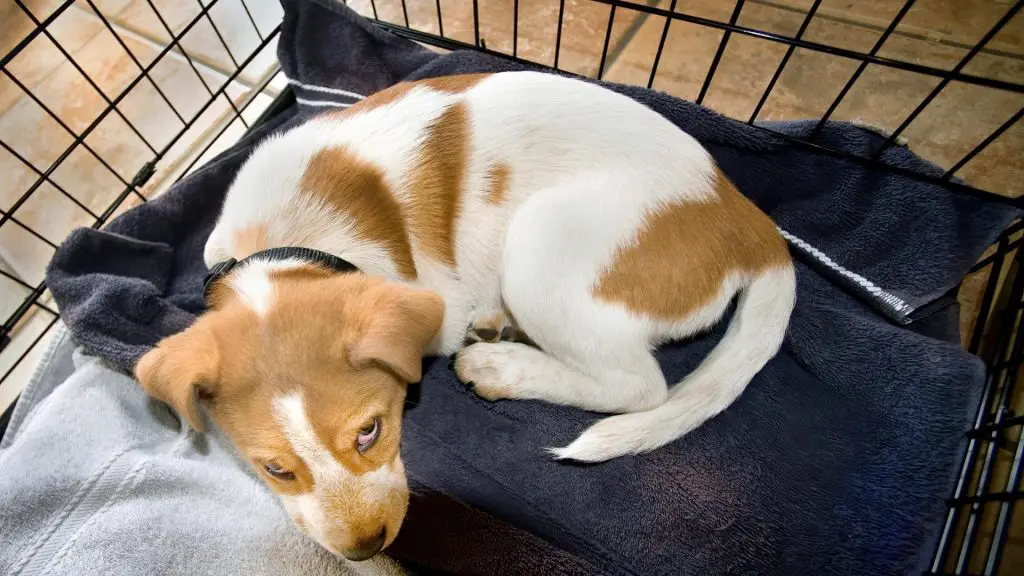
Make the crate as comfortable and inviting as you can. Think of the crate as your dog’s home inside your home. Make it a cozy place to hang out with a welcoming look.
While you might immediately think about getting them a bed to make their crate more comfortable, this is not the best idea right away.
When you’re first starting out crate training them, they’ll likely have some accidents and even washable dog beds can only handle so many accidents before they should be replaced.
A simple way to increase their comfort is giving them a piece of your clothing for their crate.
An old sweater that smells like you and you don’t plan on wearing much in the future will help them feel like you’re close even when you’re away.
Something that also helps some dogs is music or white noise while they’re in their crate.
3. Familiarize Their Crate
When you moved into a new home, it probably felt good when the furniture arrived. Suddenly, this new empty house started to finally feel like home!
The same is true with your dog’s crate. Move things into it that your dog is already attached to. Include their favorite blanket or chew toy.
A bonus for you is going to be that now you have a place to keep all of those dog toys and accessories that once cluttered up the living room.
4. Get Them Comfortable Inside
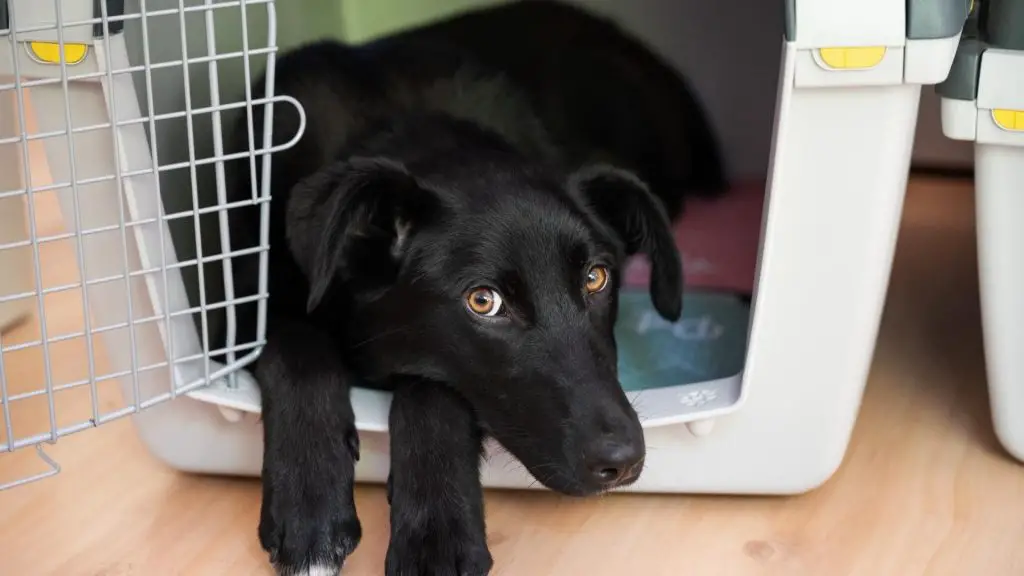
Now that you’ve laid out the welcome mat and made the crate a cozy, familiar, and comfortable place to be, it’s time to invite your anxious friend inside. Here are some helpful tips for getting your dog into the crate:
- Treats – Entice your dog using treats. Lure them inside the crate by using their favorite treats. Toss the treats into the crate and let him run in after it.
- Sleepy Time – If all else fails, wait until your dog is so tired that all they want to do is curl up in a ball and sleep. If you need to, play with them for a while right next to the crate until they become worn out.
- Command Word – Some dog owners encourage their dog to go into the crate by using a specific command word. For many, this word is “Kennel!” When they respond to the command and enter the crate, give them a treat.
Never force your dog into the crate. This will make them associate the crate with fear or even more anxiousness.
5. Shut The Door
Once you’ve successfully got your dog inside the crate, it’s time to start the process of shutting the door to the crate.
Remember, this process may take several days or longer. It totally depends on how anxious your pup is. Don’t get discouraged.
Be patient, and soon enough your dog won’t negatively react to the crate door being closed.
Once you shut the door and lock it, stay in the room at first. Do not leave your dog alone.
If you immediately shut and lock the crate door and then leave, your dog is going to be very worried and feel abandoned.
Instead, stay right there. Sit or stand next to the locked door. If you need to, talk gently to them the whole time.
For the first several times you successfully get them inside and shut the crate door, only do so for no more than 30 seconds.
Remember, this is going to take a lot of patience. It’s a gradual process and not an overnight training endeavor.
When the 30 seconds is up, open the door and let your dog out. Repeat this process several times a day.
6. Moving Further Away
After a few days of getting your dog into the crate and shutting the door but not leaving, it’s time to move up to the next level.
Now, you’re going to see how your dog reacts when you are not standing right next to the crate.
Once your dog is inside the crate, and the door is shut, move out of sight. Wait for only 30 seconds, and then return.
Open the crate, and let your dog out. If you want, give them a treat and give them some lovin’.
7. Gradually Increase Time Away

After several days, some dogs will take longer, close the door and walk away for longer periods of time. Also, experiment with turning off the lights while they’re in the crate to see how they react.
Start by extending the time you leave to one minute, and then come back. Build up to two minutes, and then longer.
Use a schedule that varies and is not predictable. For instance, stay away for 1 minute, then 2, then 5, then 11, then 7, then 2, then 12, then 3, then 14 minutes, and so forth.
As soon as you can successfully go outside for 5-10 minutes, you are on your way to success. If your dog starts to get upset, shorten the time away until you can slowly build it back up.
When you are able to stay away for 30 minutes without signs of separation anxiety, you can breathe a sigh of relief.
Once you are able to leave the room for 30+ minutes without your dog becoming upset, start leaving the house. Don’t leave for too long of periods of time.
Before you leave, give the command to go into the crate. Make sure they’re left with their favorite stuffed toy or treat.
8. How To Know When To Stop
Stop the training process immediately if your dog shows signs of anxiety. If they’re whining, trembling, crying, barking, or excessively pacing, it’s time to stop the training for the time being.
With them being all worked up you’re not likely to accomplish anything productive in terms of their training so it’s best to wait until they’re calmed down to begin training again.
9. Words Of Caution
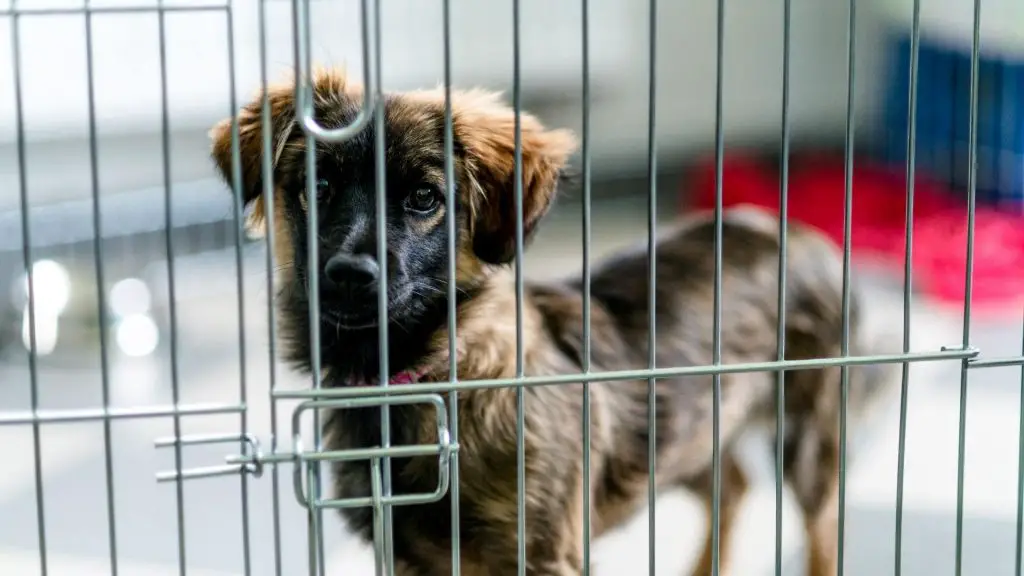
Some dogs aren’t feeling anxious, but they know how to play on your emotions. Use discernment to decipher between anxious cries for help and a dog who just wants to run around or get attention.
Some dogs catch on to the game and start to whimper or cry as if they are a toddler throwing a tantrum to get their way.
A good way to know if it is true anxiety or just a dog wanting their own way is by how quickly they recover. If they become happy and calm as soon as you take them out, most likely you have done exactly what they wanted.
10. Make It Their Home
Think of the crate as your dog’s home and not a cage. Use it often, not just for training, so that your dog becomes so familiar with it that it feels like their second home.
The more you use it during casual parts of the day, the more likely your dog will take to it as a welcoming place to be.
Important note: if you need some extra help, consider checking out this article we wrote on the best online dog training programs.
Considerations For Crate Training Dogs With Separation Anxiety
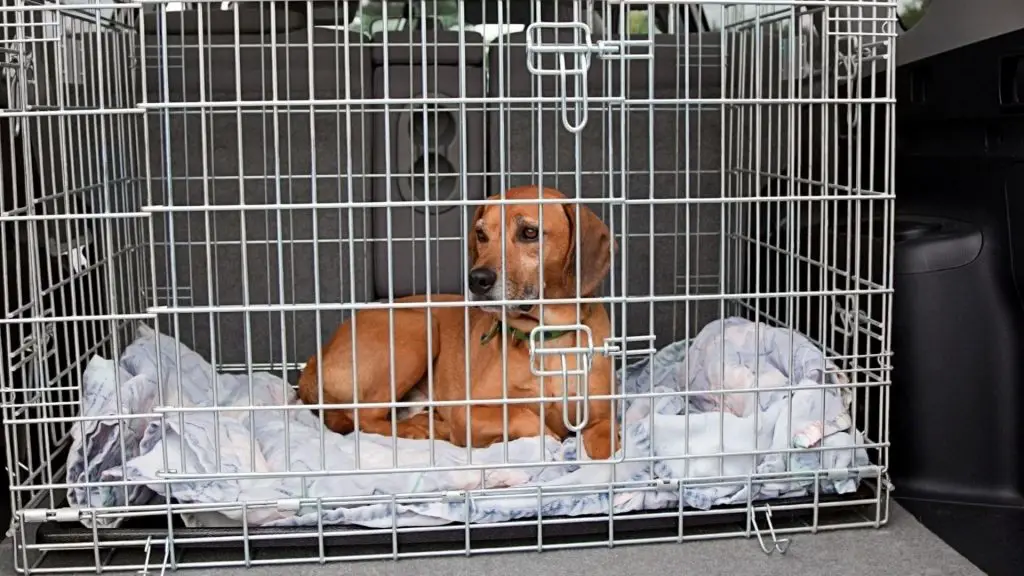
The first thing to remember is that a tender approach and a lot of patience are going to be the secrets to success when crate training an older dog with separation anxiety.
Crate training a dog with separation anxiety holds some unique challenges as opposed to a dog without.
The most important steps in how to crate train a dog with separation anxiety are:
- Make sure the crate is a comfortable spot for your dog
- Use treats to entice your dog to get inside
- Consider covering the crate with a blanket to see how they respond
- Take steps to make sure the dog associates the crate with safe, secure, and happy moments
- Do not rush the process
- Be patient and kind
Never punish a dog who has anxiety. This will only make them more anxious.
They aren’t acting out of spite or trying to get back at you for something. Your pup cannot help doing the things they do because of their anxiety.
Love and understanding will go a long way to help your dog overcome separation anxiety.
Be patient. It can take weeks or months to completely train a dog with separation anxiety.
Dog Separation Anxiety Crate
When selecting a crate for a dog with separation anxiety, it is important to choose one that will make your pup feel comfortable and safe.
The crate should be big enough for the dog to stand up and turn around in, but not so big that they can use one corner as a bathroom.
The best dog crate for seperation anxiety is the ProSelect Empire Dog Cage.
Does It Take An Older Dog Longer To Learn Crate Training?
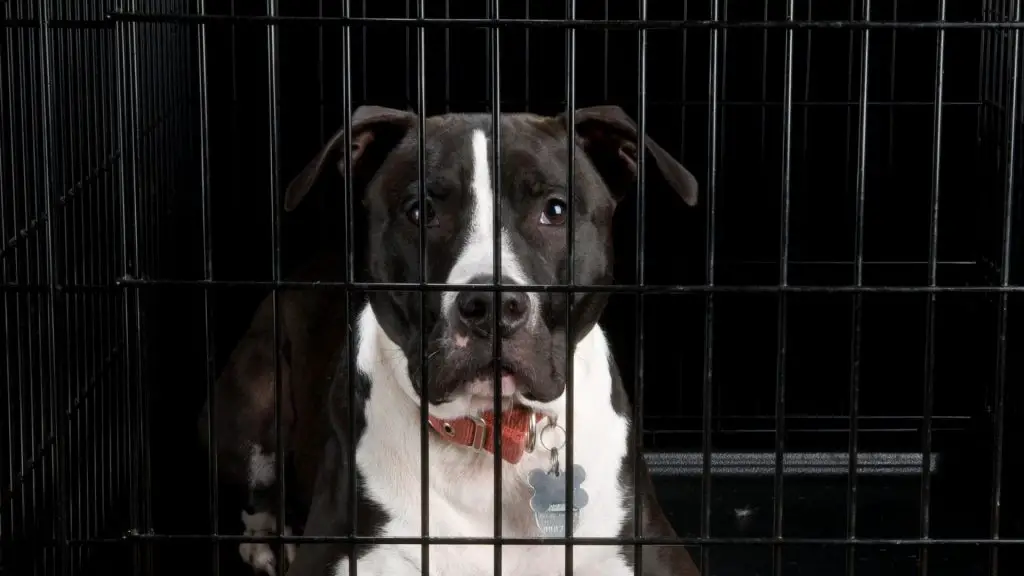
Crate training can be a challenging process for any dog regardless of their age. It’s true that older dogs generally learn slower than puppies.
When you mix separation anxiety into the process, it can take quite a while and requires a great deal of patience.
The main reason why an older dog may take more time to crate train is because they have most likely become set in their ways.
They have become used to their surroundings and how things are done and this is new to them. If they already have anxiety, transitioning them to accept a new way of doing things will be tricky.
An older dog will also need more time to accept the crate if they have become accustomed to sitting by your feet or sleeping near your bed.
Additionally, if they have not yet been crate trained at all, they are used to their freedom. An older dog is going to wonder why their life of freely roaming around is suddenly turned into time spent in a crate.
FAQs
How Long Does It Take To Crate Train A Dog With Separation Anxiety?

Crate training an anxious dog will take time, patience, and consistency. Expect it to take several weeks, or even a few months in some cases.
The key is to go slowly and make sure the dog is comfortable every step of the way. Rushing the process will only make things worse.
Is It Too Late To Crate Train An Older Dog?
No. Contrary to the saying, “you can’t teach an old dog new tricks,” it is not too late to crate train a dog of any age.
Do Dogs Grow Out Of Separation Anxiety?
Separation anxiety does not just simply go away on its own. To calm your dog and give them confidence that you will return will require a lot of patience and training on your part.
For an older dog who has gotten used to being anxious, they may not know how to act any other way.
What Does Separation Anxiety Look Like In Dogs?
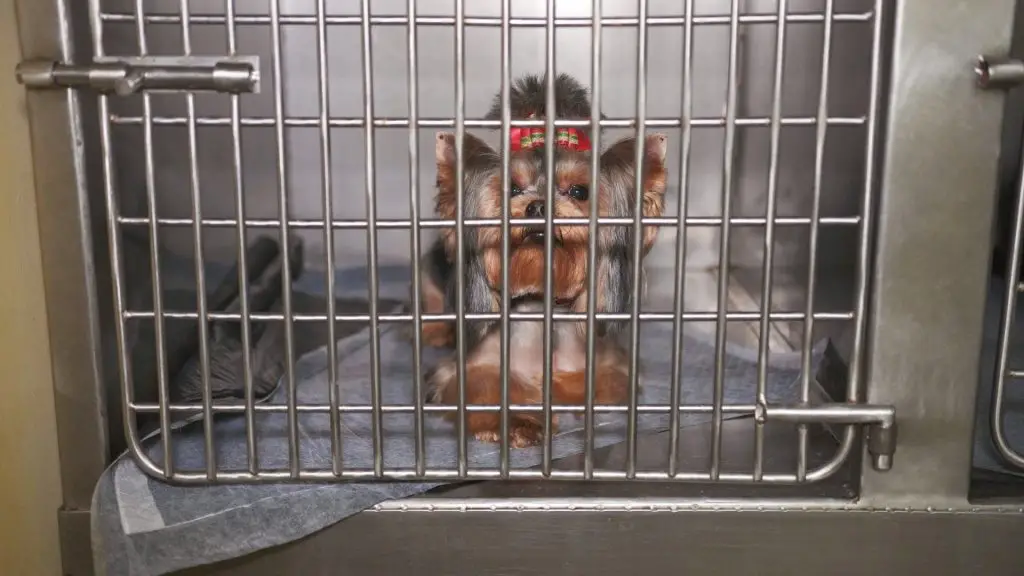
Dogs suffering from separation anxiety tend to whine, cry, or tremble. Barking or howling loudly and for long periods of time during your absence are also common characteristics of separation anxiety.
Final Thoughts
Think of a crate as a safe haven for your dog. Almost as if it’s their own bedroom or home inside your home. Eventually, your dog will learn to be less anxious when you leave.
With time they will likely learn to enjoy their crate, instead of just putting up with it.
Remember that patience is going to be the key ingredient to successfully crate train an older dog with separation anxiety.
Other posts you might find interesting:
Where Should I Put A Dog Crate In My House
How To Make A Dog Crate Escape Proof | Simple Tricks
10 Best Dog Crates for Separation Anxiety: The Ultimate Guide
